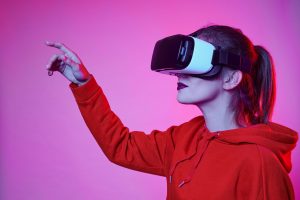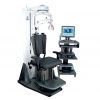
FDA Approves VR Device for Back Pain Treatment
Treatment GuidelinesEaseVRx is an FDA-approved virtual reality device used in the treatment of chronic low back pain. It is the only VR-based device currently used in the treatment of low back pain.
If you are reading this post, you are likely as excited as I am about the new VR (virtual reality) device approved by the FDA. In November of 2021, the FDA approved a new VR device for treatment of low back pain, EaseVRx. This is an exciting new treatment option that could change the future of back pain treatment.
In this post, we will review how this new FDA-approved VR device will help lower medical costs while improving patient outcomes; and what it all means for the future. Let’s dive in!
What is EaseVRx?
EaseVRx is an FDA-approved virtual reality device used in the treatment of chronic low back pain. It is the only VR-based device currently used in the treatment of low back pain1. It utilizes cognitive behavioral therapy techniques to help change how we think about pain and help us develop coping mechanisms to treat chronic pain.
The EaseVRx dynamic platform offers pain treatment through education, pain distraction, relaxation, mindful escapes, and dynamic breathing1. Clinically proven, it’s a non-invasive treatment option for those suffering from back pain longer than three months. According to EaseVRx’s recommendations, people should use the device seven days per week for a total of eight weeks. Patients can use the device from the comfort of their own homes, hassle-free1.
Efficacy of EaseVRx
A study conducted in the Journal of Medical Internet Research (JMIR) looked at the efficacy of EaseVrx through a randomized double-blind clinical trial in December 20202. Participants had to meet the criteria of nonmalignant lower back pain for greater than six months with an average pain rating of at least four out of 102. The study separated the 179 participants into two groups; the first group used the EaseVrx 3D system while the second used a placebo 2D VR system. The participants used each VR system daily for eight weeks, for a total of 56 treatment sessions2.
Now to the exciting part! The results yielded both higher user ratings and better pain outcomes in the EaseVRx system when compared to the placebo VR system2. User ratings refer to participants’ satisfaction with using the product. More significantly, 66% of EaseVRx users reported a pain reduction of more than 30%, compared to only 41% placebo users2. Other findings included EaseVRx users experienced a 42% reduction in pain intensity, 49% reduction in pain with activity, a 52% reduction in pain with sleep, and 57% reduction in pain with stress2.
Why Does It Matter?
As healthcare providers, we all have seen our fair share of patients with low back pain. According to the CDC, 25% of the U.S population has experienced low back pain in the last three months3. Americans spent $136 billion from 1996 to 2016 on low back and neck conditions alone, which is more than both diabetes and heart disease4. In addition to personal insurance costs, low back pain accounts for the majority of the $100 billion spent annually on worker’s compensation claims. With the growing aging population, these numbers are likely to keep increasing for years to come.
Opioids for Low Back Pain
Opioids have been readily prescribed for the treatment of low back pain since the 1990s. The medical community has been working to find more alternative and less invasive pain management treatment options. Here are a few statistics which give more reason to finding more effective treatment options like EaseVRx:
- 10 million people misused opioids in the last year5
- 70,000 Americans died in 2019 from an opioid overdose5
- 1.6 million people had an opioid use disorder in the past year5
It is well understood that prescription opioids come with a laundry list of potential side effects. EaseVRx helps reduce those side effects by offering a safe, effective, and less-invasive alternative to the treatment of chronic low back pain.
The Future of Low Back Pain Treatment
With the advancement of technology and shifting towards more digital healthcare, more and more at-home remedies are surfacing. Hopefully, EaseVRx will help shift chronic low back pain management from opioids to self-directed care through cognitive behavioral therapy (CBT).
With CBT, patients can become more active in their treatments and learn various coping mechanisms which can lead to longer-lasting pain relief. For more information on the effectiveness of CBT, check out this article here.
EaseVRx is intended to be used in the comfort of the patient’s own home; however, I see an opportunity for clinics to have a unit on-site. For patients who may need a bit more direction, providers can set up the device and facilitate its use. However, because of its passive, hands-off approach, I doubt insurance companies will reimburse providers for its use during therapy sessions. Therefore, for practical reasons, providers will likely use EaseVRx as an adjunct to their typical therapy measures.
Final Thoughts
EaseVRx could be the next great VR tool used in the treatment of chronic pain. By using CBT, patients can learn valuable coping mechanisms to help alter the way they think about pain. EaseVRx can optimize long-term management of chronic pain through these coping mechanics and shift away from more short-term treatments such as opioids. However, more research to further verify the efficacy of VR in the treatment of chronic pain. That said, the future of chronic low back pain treatment is looking bright!
Justin Melson, PT, DPT
Justin Melson, PT, DPT is a Physical Therapist and freelance healthcare content writer. He has been contributing content since 2020 for numerous healthcare start-ups and healthcare magazines. Writing allows him to share information with a greater audience as well as blend his passion for healthcare and helping others. Feel free to reach out on: theptunicorn, LinkedIn, and UpWork.
References:
- Now Approved | EaseVRx. www.easevrx.com. Accessed December 6, 2021. https://www.easevrx.com
- Garcia LM, Birckhead BJ, Krishnamurthy P, et al. An 8-Week Self-Administered At-Home Behavioral Skills-Based Virtual Reality Program for Chronic Low Back Pain: Double-Blind, Randomized, Placebo-Controlled Trial Conducted During COVID-19. Journal of Medical Internet Research. 2021;23(2):e26292. doi:10.2196/26292
- Acute Low Back Pain | Acute Pain. www.cdc.gov. Published May 11, 2020.
- Americans Spend More on Back, Neck Pain Than Any Other Health Issue. Healthline. Published March 4, 2020.
- S. Department of Health and Human Services. What is the U.S. Opioid Epidemic? HHS.gov. Published 2019.







